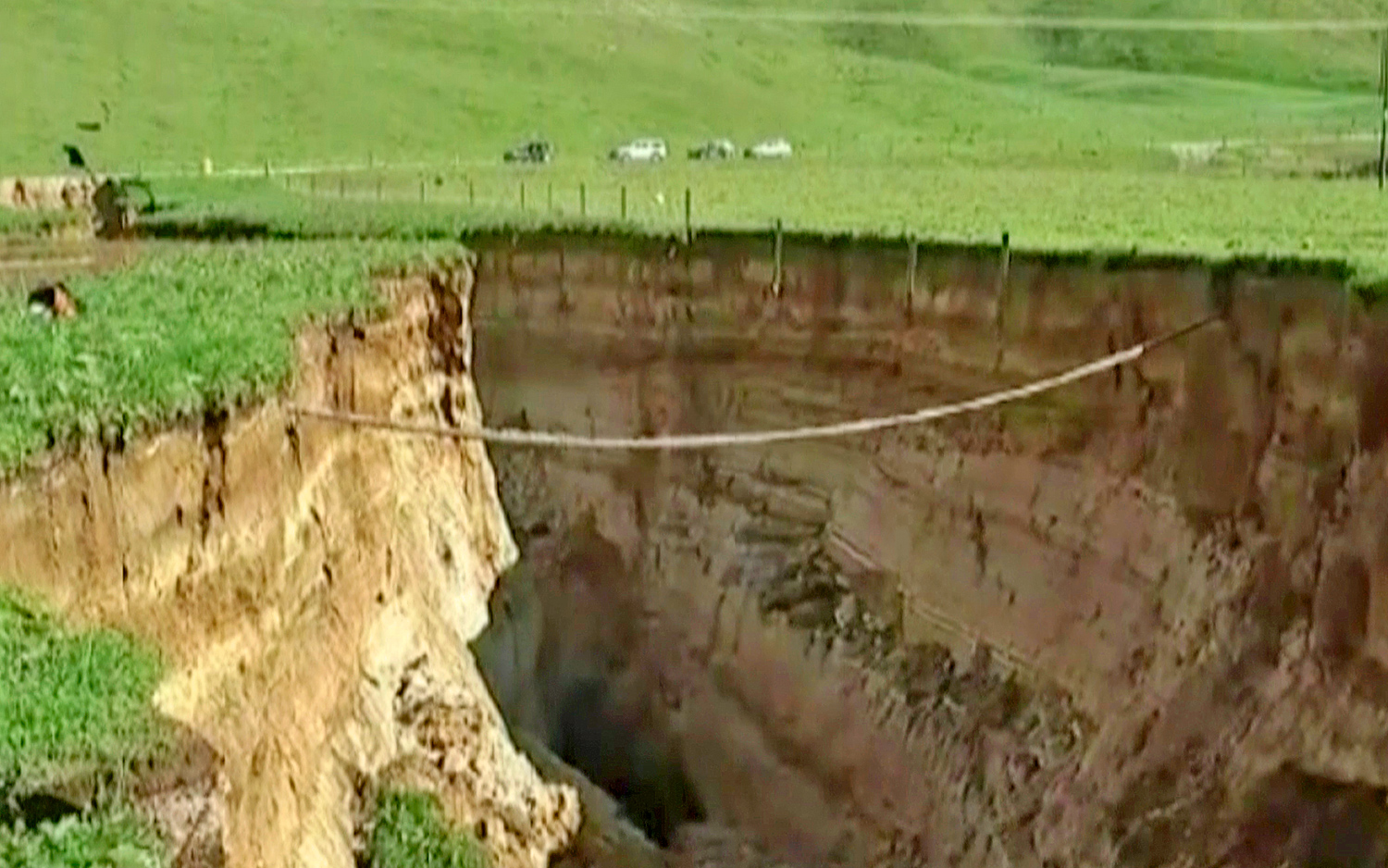Enormous New Zealand Sinkhole to Be Fenced in So Cows Aren't Swallowed Up

While rounding up cows before the crack of dawn last week, a New Zealand farm worker happened upon a gaping gouge in the earth as long as two football fields, according to AP News. It seems to have appeared overnight.
The farm manager, Colin Tremain — who woke up with a hole in his field that could hold a six-story building — is making plans to surround the giant sinkhole with fences so it doesn't swallow any cows, according to AP News and CNN. Meanwhile, volcanologists are peering inside for clues to a volcano's past.
The farm sits on top of the crater of a dormant volcano, according to CNN. Bradley Scott, a volcano information specialist at GNS Science in New Zealand, told broadcast television station TVNZ that he could see the remains of a 60,000-year-old volcanic deposit at the bottom. [Photos: The World's Weirdest Geological Formations].
Stacked on top of the 60,000-year-old volcanic deposit are about 30 feet to 65 feet (10 to 12 meters) of sediments left over from lakes that occupied the crater in the past. Sprinkled on top is volcanic ash, according to Scott. The sinkhole that opened up in this crater is 656 feet (200 meters) long and about 65 feet (20 meters) deep. And it is allowing volcanologists a glimpse into the volcano's past.
How do sinkholes open up?
According to Tremain, this region of New Zealand commonly experiences sinkholes because the land sits on top of limestone. Sinkholes most commonly form when there are carbonate rocks like limestone or other soluble rocks underneath the ground, according to Adam Milewski, an associate professor of hydrogeology at the University of Georgia. Water flowing in from rain or rivers can be acidic due to pollution but more likely turns acidic underground by picking up other materials. As the water seeps through the ground, it chemically reacts with the rocks. Over time, those rocks dissolve, leaving behind cavities, according to Milewski. Geologists call this type of landscape that sits on limestone, "karst terrain."
There are three major types of sinkholes, according to Milewski. The first, a cover-collapse sinkhole, occurs when the land collapses suddenly, usually when the belowground cavities get too large and there's nothing below to hold the weight of the soil above (which can also get incredibly heavy following days of rain). The second type, called cover-subsidence sinkholes, happen when parts of the soil at the surface begin to sink down into underground cavities, creating small, but visible, depressions in the land. The third type are called dissolution sinkholes, and they occur when there isn't much soil or vegetation on top of the limestone, so water starts to dissolve those rocks near the surface, creating a depression that can turn into a pond, according to the U.S. Geological Survey.
Since this sinkhole in New Zealand opened after days of intense rainfall, it was probably a "cover-collapse sinkhole," according to Milewski. "I suspect that [the bedrock] had dissolved a long time ago and continued to dissolve; and in this particular case, the water kept adding a lot of pressure to [the soil]," Milewski told Live Science. [Insane Photos of Sinkholes].
Sign up for the Live Science daily newsletter now
Get the world’s most fascinating discoveries delivered straight to your inbox.
Paul Wetmore, an associate professor of geology at the University of South Florida, also said that the sinkhole could have been caused by "caves carved through limestone" below the lava that the volcanologists spotted. But he also suggested another possible cause.
"Sinkholes are not uncommon in volcanic terrains, particularly those composed of basalts like the lavas currently erupting in the East Rift Zone in Hawaii right now," Wetmore said. As lava flows, the top cools and hardens over, but the bottom continues flowing, forming tunnels called lava tubes. When the lava flow stops, these tubes typically are left as empty tunnels. With time, the frozen roof can develop cracks and eventually collapse.
Fractures in the ground from seismic activity like earthquakes can also spur sinkholes to form, since those cracks allow water to move through and dissolve the rock much faster, Milewski said. In the case of New Zealand, the sinkhole appeared both on top of a fault line, following days of heavy rain, and on top of a dormant volcano's crater, according to CNN. [Look Out Below! 8 Amazing Sinkholes].
By studying the material in the sinkhole, volcanologists might be able to determine how many times the volcano has erupted in its past, Milewski said.
"They're making a good situation out of a bad event," Milewski said. "The hard part for all of us is that all of the things we generally like to study are in the ground." So when the ground opens up, it offers geologists a rare glimpse in.
Originally published on Live Science.

Yasemin is a staff writer at Live Science, covering health, neuroscience and biology. Her work has appeared in Scientific American, Science and the San Jose Mercury News. She has a bachelor's degree in biomedical engineering from the University of Connecticut and a graduate certificate in science communication from the University of California, Santa Cruz.










